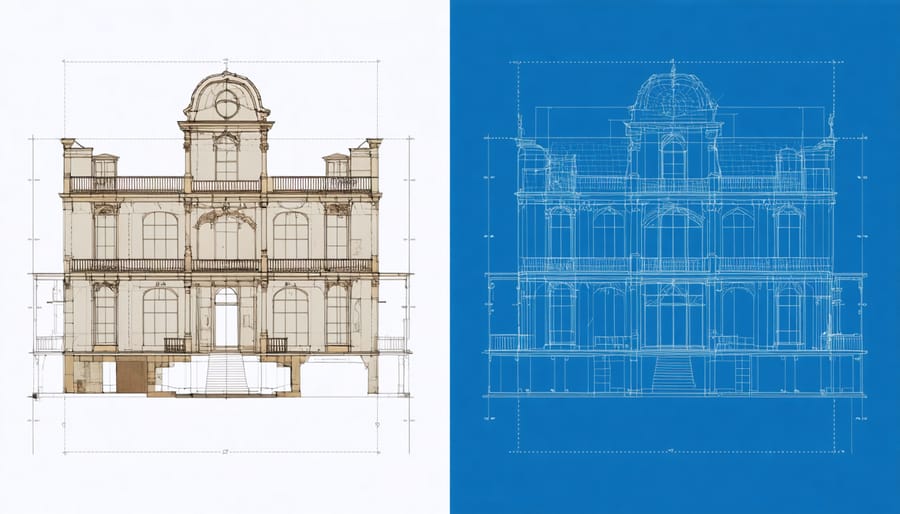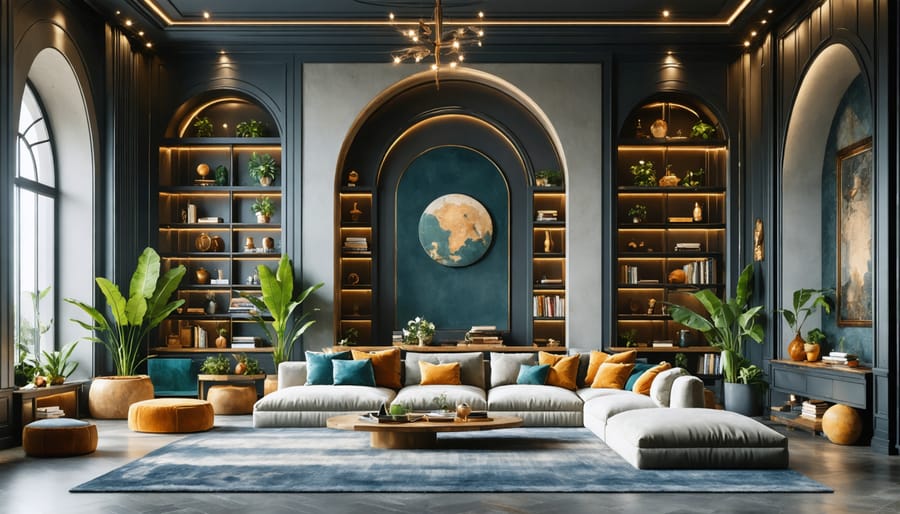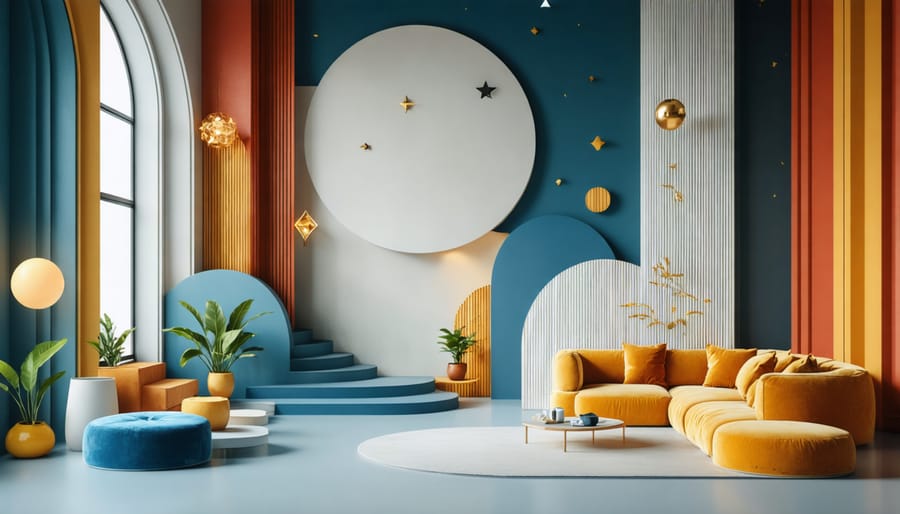The intricate dance between interior design and architecture has shaped our built environment for centuries, blending form and function in ways that define how we experience spaces. While architecture creates the fundamental structure and bones of a building, interior design breathes life into these spaces, transforming them into functional, aesthetically pleasing environments that serve human needs. This relationship isn’t merely complementary—it’s symbiotic. Today’s architects and interior designers increasingly collaborate from a project’s inception, recognizing that successful spaces require both structural integrity and thoughtful interior planning.
Think of architecture as the symphony’s composition and interior design as its interpretation—both essential to creating a memorable performance. From the grand halls of historic palaces to modern minimalist homes, the seamless integration of these disciplines creates spaces that not only stand strong but also tell compelling stories. This dynamic partnership becomes especially evident in contemporary design, where the boundaries between indoor and outdoor spaces blur, and where every structural decision impacts the interior experience.
As we explore this relationship, we’ll discover how these two fields work together to create spaces that are not just buildings, but experiences—proving that while architecture and interior design are distinct disciplines, they’re inseparable in creating truly exceptional spaces.
The Architectural Foundations of Interior Design
Historical Evolution
Interior design and architecture have been intertwined since ancient civilizations, where master builders considered both the structural elements and living spaces of their creations. In ancient Egypt and Rome, architects were responsible for both the building’s form and its interior aesthetics, creating harmonious spaces that reflected cultural values and social status.
During the Renaissance, this unified approach continued, with legendary figures like Michelangelo and Palladio designing both buildings and their interiors. However, the Industrial Revolution marked a significant shift. As buildings became more complex and specialized knowledge was required, interior design gradually emerged as a distinct profession in the late 19th century.
The early 20th century saw the rise of influential movements like the Bauhaus school, which emphasized the integration of art, craft, and technology. This period also witnessed the emergence of celebrated interior designers like Elsie de Wolfe, who helped establish interior design as a respected profession separate from architecture.
Today, while interior design has evolved into its own specialized field, it maintains strong ties to its architectural roots, with many professionals working collaboratively to create cohesive living spaces.

Shared Principles
Interior design and architecture share several fundamental design principles that form the backbone of creating harmonious spaces. Both disciplines emphasize the importance of balance, proportion, and scale in their approach to design. Whether you’re planning a room’s layout or designing an entire building, these principles guide decision-making and ensure aesthetic cohesion.
Space planning serves as a crucial bridge between the two fields. Architects and interior designers both consider how people move through spaces, focusing on flow and functionality. They share an understanding of light manipulation, using both natural and artificial sources to enhance spatial experiences. Materials selection is another common ground, with both professionals carefully choosing elements that complement each other while serving practical purposes.
Both fields also prioritize the relationship between form and function. While architects might focus on structural integrity and exterior appeal, interior designers ensure the inside spaces work efficiently while maintaining visual appeal. This shared emphasis on combining beauty with practicality creates spaces that are not only stunning to look at but also comfortable to live in.
Maximalism: Where Architecture Meets Interior Design
Structural Elements in Maximalist Spaces
In maximalist interior design, architectural elements serve as the canvas and framework for bold creative expressions. High ceilings, for instance, provide the perfect opportunity to showcase dramatic chandeliers or hanging art installations, while large windows become natural focal points for layered window treatments and dramatic drapery.
Load-bearing walls and columns, rather than being hidden away, can be transformed into statement features through the application of intricate wallpapers, decorative moldings, or even become impromptu gallery walls. Archways and doorways become natural transition points that can be enhanced with bold paint colors or ornate trim work, creating purposeful divisions between different design zones.
Built-in elements like fireplaces, bookcases, and window seats offer prime real estate for maximalist styling. These architectural features provide natural staging areas for displaying collections, incorporating rich textiles, and layering decorative elements without compromising the room’s functionality.
The structural grid of a space often dictates furniture placement and traffic flow, even in maximalist designs. Smart maximalists work with these architectural constraints, using them to create intentional vignettes and conversation areas. For example, ceiling beams can guide the placement of lighting fixtures, while room divisions suggest natural spots for room dividers or sculptural furniture pieces.
Remember that successful maximalist spaces don’t fight against architectural elements but rather embrace and enhance them. The key is to let the building’s bones guide your design choices while adding layers of personality through color, pattern, and texture. This creates spaces that feel both intentional and organically evolved, rather than chaotic or overwhelming.

Space Planning and Flow
When it comes to maximalist design, space planning and flow becomes even more crucial than in minimalist spaces. Architects and interior designers must work together to create layouts that can accommodate abundant decorative elements while maintaining functionality. This collaboration ensures that even the most elaborately decorated rooms remain navigable and purposeful.
In maximalist spaces, the architectural principles of circulation and spatial hierarchy take center stage. Designers must carefully consider traffic patterns, ensuring clear pathways between furniture groupings despite the rich visual elements. They often create “zones” within larger spaces, using architectural features like columns, level changes, or built-in furniture to define different functional areas.
The key to successful maximalist room layouts lies in understanding the relationship between positive and negative space. While maximalism embraces fullness, it’s essential to maintain breathing room around key architectural elements. This might mean leaving clean sight lines to dramatic windows or keeping doorways uncluttered, even while surrounding walls burst with pattern and color.
Furniture placement in maximalist designs requires careful consideration of both scale and proportion. Large pieces should respect the room’s architectural framework, while smaller decorative elements can be layered within these established boundaries. The goal is to create a space that feels abundant and engaging without overwhelming the room’s inherent architectural features.
Remember that even in maximalist design, the fundamental architectural principle of form following function still applies. Each design decision should enhance, not hinder, the room’s intended purpose, creating spaces that are both visually exciting and practically livable.
Creating Maximalist Spaces: The Architectural Approach

Layering and Scale
Layering in maximalist design is where architecture and interior design truly dance together. Start with the room’s architectural bones – crown moldings, window frames, and built-in elements – as your foundation. These structural features create natural depth that you can enhance through thoughtful design choices.
Consider treating your space like a theatrical set, where each layer adds dimension. Begin with wall treatments that complement architectural details – think textured wallpaper behind ornate moldings or bold paint colors that highlight architectural niches. Next, layer in furniture at varying heights, creating a visual journey from floor to ceiling.
Use architectural principles of scale to your advantage. Large windows can be enhanced with dramatic floor-to-ceiling curtains, while built-in shelving becomes more impactful when styled with objects of varying sizes. Don’t shy away from oversized artwork or mirrors that draw attention to high ceilings or interesting architectural angles.
Remember that successful layering requires balance. While maximalism embraces abundance, use architectural elements as your guide for proportions. A room with detailed crown molding might call for equally elaborate light fixtures, while clean-lined modern architecture might need bold furniture pieces to create contrast.
For depth, work in thirds: background (architectural elements), middle ground (larger furniture), and foreground (decorative pieces). This approach ensures your maximalist design feels intentional rather than cluttered, while honoring the room’s architectural integrity.
Material Selection
Material selection in maximalist design is where architecture and interior design truly converge, creating spaces that are both structurally sound and visually captivating. When embracing maximalism, architects and designers often lean towards materials that make bold statements while maintaining functionality.
Natural stone, particularly marble with dramatic veining, serves as both a structural element and a decorative feature. Its inherent patterns and variations contribute to the layered look that maximalism celebrates. Similarly, richly grained woods can be used for both architectural elements and decorative finishes, adding warmth and texture to spaces.
Metallic finishes play a crucial role in maximalist design, with brass, copper, and gold-toned materials being particularly popular. These can be incorporated into both structural elements like door frames and decorative features like light fixtures. Glass, especially when used in creative ways such as colored or textured panels, can serve both architectural and decorative purposes.
For walls and ceilings, materials that offer visual interest like textured plaster, embossed wallpaper, or dimensional tiles can transform basic architectural elements into statement features. The key is to select materials that work together harmoniously while still making an impact.
When choosing materials, consider how they’ll interact with lighting and other design elements. The best selections often fulfill both structural requirements and aesthetic goals, proving that architecture and interior design are indeed inseparable in creating cohesive maximalist spaces.
Lighting Design
In maximalist spaces, lighting plays a pivotal role in bringing architectural elements to life while harmonizing the abundance of decorative features. Understanding architectural lighting principles is crucial for creating balanced, visually striking interiors that don’t feel overwhelming.
Layer your lighting sources to create depth and dimension. Start with ambient lighting through strategically placed ceiling fixtures or recessed lights, then add task lighting for functional areas. Accent lighting becomes particularly important in maximalist spaces, highlighting architectural features, artwork, or decorative elements that might otherwise get lost in the visual abundance.
Consider using dramatic fixtures that double as artistic statements – think oversized chandeliers or sculptural sconces. These pieces can serve as focal points while providing necessary illumination. Don’t shy away from mixing lighting styles, but maintain a cohesive thread through finish selections or design elements.
Temperature and intensity control are essential in maximalist spaces. Install dimmers to adjust the mood and emphasize different design elements throughout the day. Cool white lights can make spaces feel larger and showcase colorful details, while warm lighting creates an intimate atmosphere that softens bold patterns and textures.
Remember to balance natural and artificial light sources. Use window treatments that can be adjusted to control daylight, complementing your artificial lighting scheme while highlighting architectural features like moldings, archways, or built-in elements.
Professional Integration
In maximalist design projects, interior designers and architects work hand in hand to create bold, layered spaces that push creative boundaries while maintaining structural integrity. This collaboration typically begins in the early planning stages, where architects establish the foundational elements and spatial layout while interior designers contribute insights about flow, functionality, and aesthetic potential.
The integration becomes particularly crucial in maximalist projects, where every surface and corner presents an opportunity for artistic expression. Architects ensure that decorative elements like oversized chandeliers or floor-to-ceiling bookcases can be safely supported by the structure, while interior designers bring these dramatic features to life through careful curation and placement.
Regular site meetings between both professionals help resolve challenges unique to maximalist spaces, such as incorporating complex pattern layering or managing the visual weight of multiple statement pieces. The architect might modify ceiling heights or window placements to accommodate elaborate wall treatments or dramatic drapery, while the interior designer ensures these structural elements enhance rather than overwhelm the overall design scheme.
Technology plays a vital role in this collaboration, with both teams often using 3D modeling software to visualize how architectural features and interior elements work together. This helps identify potential conflicts early and allows for creative problem-solving before construction begins.
The most successful maximalist projects emerge when both professionals respect each other’s expertise while pushing creative boundaries together. Whether it’s determining the perfect placement for a load-bearing wall that doubles as an art installation or ensuring adequate lighting for multiple focal points, this partnership creates spaces that are both structurally sound and visually spectacular.
In the vibrant world of maximalist design, interior design and architecture dance together in perfect harmony, creating spaces that are both structurally sound and aesthetically captivating. The relationship between these two disciplines becomes particularly evident when working with bold patterns, layered textures, and dramatic architectural elements that define maximalist spaces. Rather than competing, architecture provides the essential framework while interior design brings personality and life to these spaces through careful curation and artistic expression.
The success of a maximalist space relies heavily on this seamless integration – where architectural features like grand windows, ornate moldings, and dramatic ceiling heights work in concert with interior design elements such as rich color schemes, eclectic furniture arrangements, and statement decorative pieces. This partnership demonstrates that interior design isn’t just an afterthought to architecture but an integral part of the complete design process.
For homeowners and design enthusiasts embracing maximalism, understanding this relationship helps create more cohesive and intentional spaces where every element, from the building’s bones to the smallest decorative detail, contributes to a unified vision of abundant beauty and personal expression.
